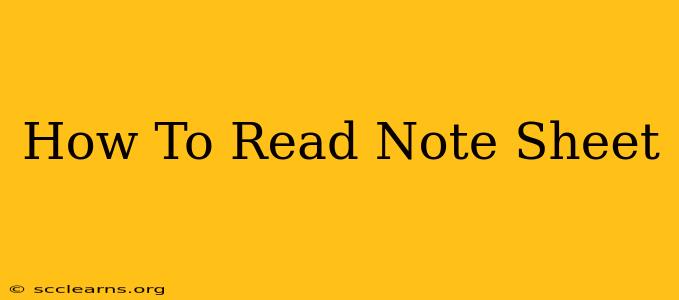Reading a note sheet effectively is a crucial skill for musicians, students, and anyone who works with written musical notation. Whether you're a seasoned performer or just starting your musical journey, understanding how to interpret these symbols is key to unlocking the beauty and complexity of music. This comprehensive guide will walk you through the essentials, covering everything from basic note values to more complex rhythmic and melodic elements.
Understanding the Basics: Staff, Clef, and Notes
Before diving into complex arrangements, let's establish a firm foundation. A note sheet, also known as sheet music, primarily uses a staff, which is a set of five horizontal lines and the spaces between them. The clef, a symbol at the beginning of the staff, tells us which notes correspond to which lines and spaces. The most common clefs are the treble clef (often called the "G clef") and the bass clef (often called the "F clef").
- Treble Clef: Generally used for higher-pitched instruments and voices.
- Bass Clef: Used for lower-pitched instruments and voices.
Each line and space on the staff represents a specific musical pitch. Notes are placed on these lines and spaces to indicate the melody. The higher the note on the staff, the higher its pitch.
Note Values and Rhythms
Notes aren't just about pitch; they also represent duration, or how long a note is held. Different note shapes indicate different durations:
- Whole Note: A hollow oval, representing the longest note value.
- Half Note: A hollow oval with a stem, half the length of a whole note.
- Quarter Note: A filled-in oval with a stem, half the length of a half note.
- Eighth Note: A filled-in oval with a stem and a flag, half the length of a quarter note.
- Sixteenth Note: Similar to an eighth note, but with two flags, half the length of an eighth note. And so on...
Rests represent silence in music. Just like notes, rests have different values corresponding to note durations.
Interpreting Time Signatures and Key Signatures
Two crucial elements found at the beginning of a piece of music are the time signature and the key signature.
Time Signatures
The time signature, a fraction-like symbol, tells us how many beats are in each measure and which note value gets one beat. For example, a 4/4 time signature (common time) means four quarter notes per measure.
Key Signatures
The key signature, a set of sharps (#) or flats (♭) at the beginning of the staff, indicates the key of the piece. This determines which notes will be naturally sharp or flat throughout the music.
Understanding Dynamics and Articulation
Beyond pitch and rhythm, note sheets also convey information about how the music should be played:
- Dynamics: Instructions for volume (e.g., piano for soft, forte for loud).
- Articulation: Instructions for how notes should be played (e.g., legato for smooth and connected, staccato for short and detached).
Putting it All Together: Reading a Simple Piece
Let's consider a simple example: a piece in 4/4 time with a treble clef. By understanding the note values, time signature, and any dynamics or articulation markings, you can accurately interpret the rhythm, melody, and expression intended by the composer.
Tips for Effective Note Reading
- Practice Regularly: Consistent practice is key to improving your sight-reading skills.
- Start with Simple Pieces: Begin with easy arrangements and gradually increase difficulty.
- Use a Metronome: This helps develop a sense of rhythm and timing.
- Listen to Recordings: Hearing the music alongside the sheet music can enhance your understanding.
- Break Down Complex Passages: Don't try to learn everything at once. Focus on smaller sections, mastering each before moving on.
Reading note sheets might seem daunting at first, but with patience, practice, and a structured approach, you can master this fundamental skill and unlock a world of musical possibilities. So, grab your sheet music, and start making music!

